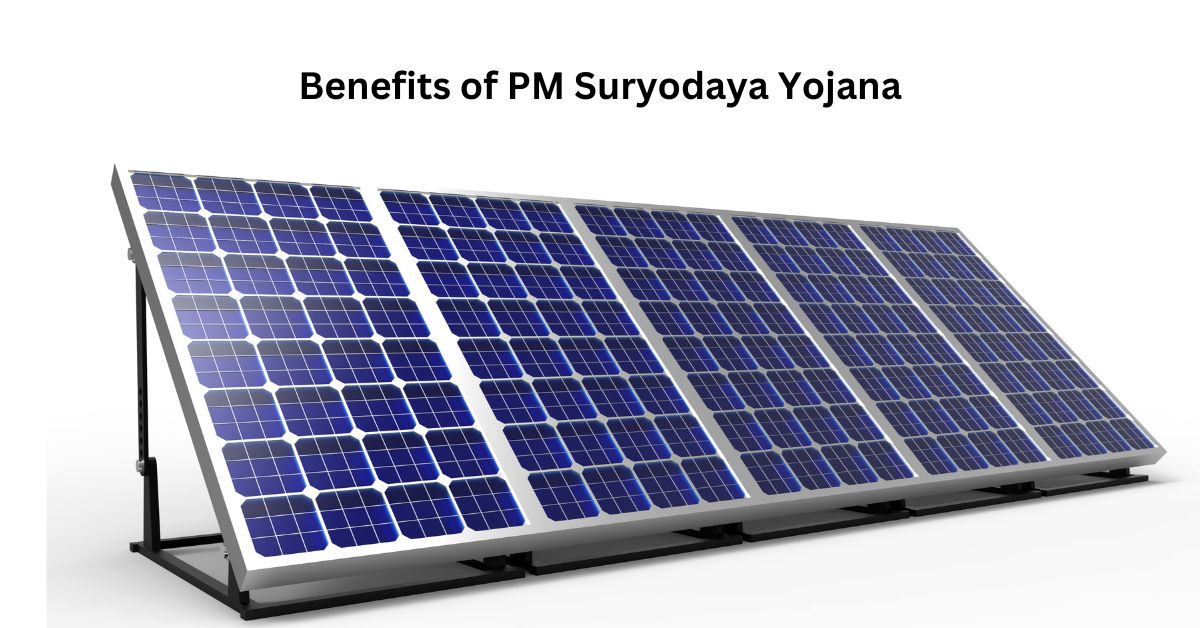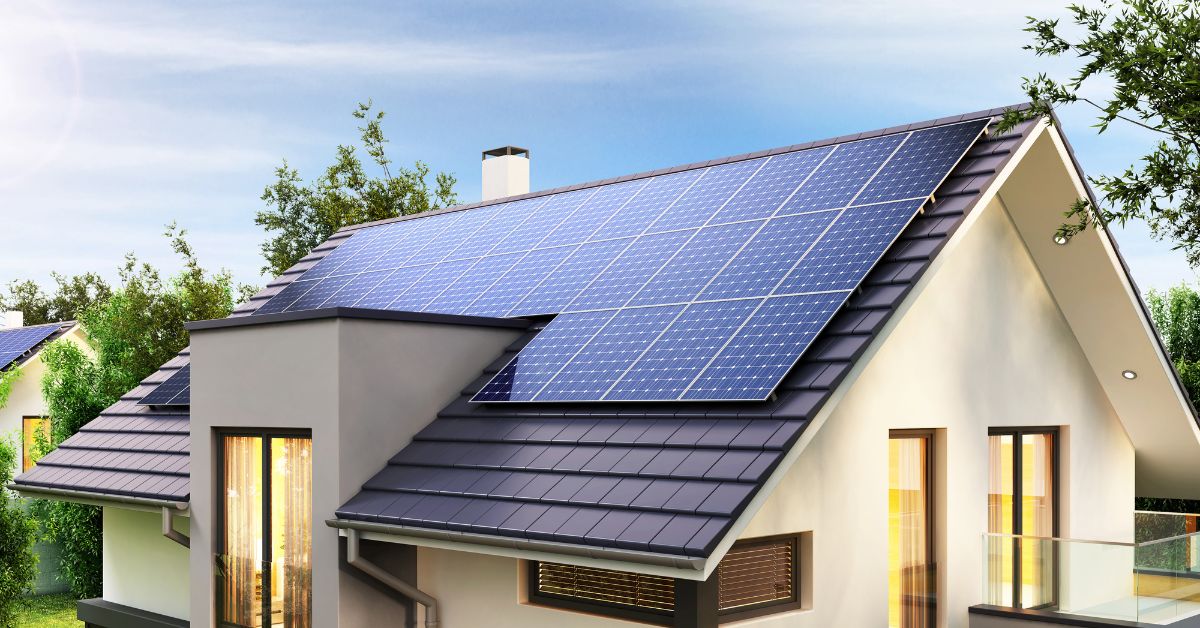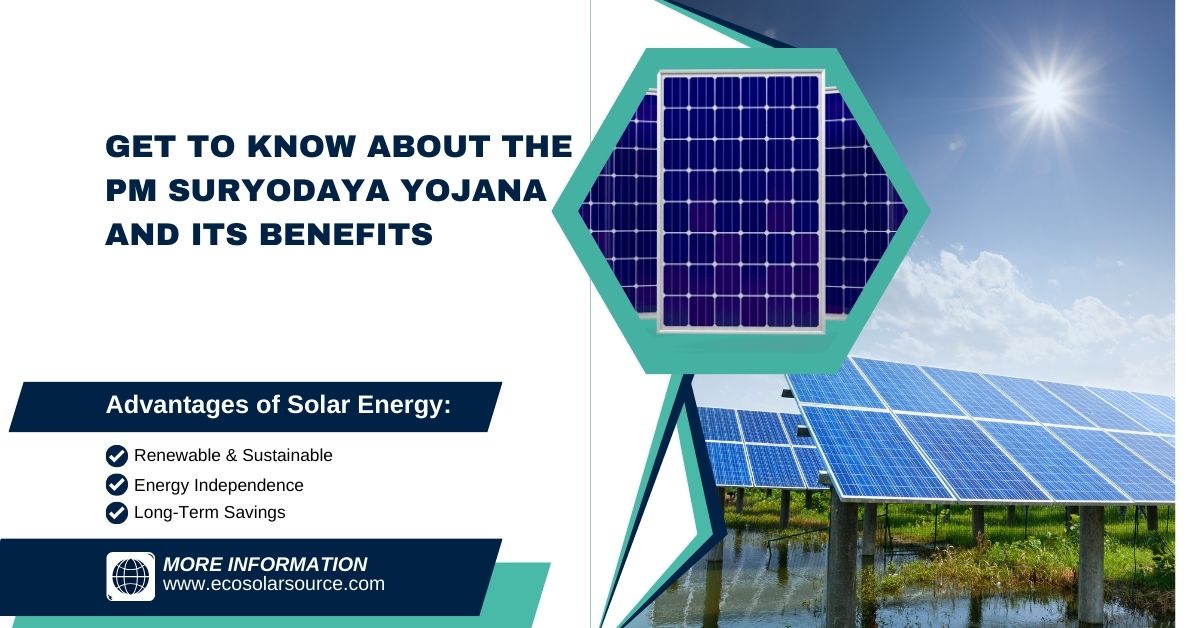Get to Know About the PM Suryodaya Yojana and Its Benefits
Know the details about Get to Know About the PM Suryodaya Yojana and Its Benefits, The PM Suryodaya Yojana is a government initiative aimed at promoting renewable energy by providing solar power access to rural and underserved areas of India. This scheme focuses on harnessing solar energy to improve the availability of electricity in remote regions, reducing dependence on traditional power grids.
The program aims to enhance energy security, support sustainable development, and reduce carbon emissions. Key benefits include lower electricity costs, job creation in the renewable energy sector, improved energy access for marginalized communities, and a significant contribution to India’s climate goals by expanding the use of clean, green energy sources.
Table of Contents
Please Get to Know About the PM Suryodaya Yojana and Its Benefits
India has always been at the forefront of adopting sustainable development strategies, and one of the key pillars of this approach is renewable energy. With the increasing demand for electricity and the country’s commitment to combating climate change, the Indian government has introduced several initiatives to promote clean energy sources. Among these efforts is the PM Suryodaya Yojana, a government scheme encouraging the adoption of solar power across the nation. This scheme is designed to boost India’s renewable energy capacity and empower households, industries, and rural communities through access to affordable and sustainable electricity.
In this blog post, we will explore in depth the PM Suryodaya Yojana, its objectives, the benefits it offers to individuals and communities, and how it aligns with India’s overall renewable energy strategy.
What is PM Suryodaya Yojana?
The PM Suryodaya Yojana (Pradhan Mantri Suryodaya Yojana) is a government initiative designed to promote the use of solar energy in India. Launched as part of the government’s broader push for renewable energy, the scheme aims to make solar power more accessible to both urban and rural populations. It focuses on the generation of electricity using solar photovoltaic (PV) systems, which convert sunlight into electricity. The program encourages the installation of solar panels on rooftops and in larger solar parks, providing a viable alternative to traditional energy sources.
The name “Suryodaya” itself means “Sunrise,” signifying the beginning of a new era of sustainable energy. The scheme forms a part of India’s National Solar Mission, which was launched to achieve 100 GW of solar power capacity by 2022 (later revised to 280 GW by 2030). By facilitating the growth of solar energy in both urban and rural settings, the PM Suryodaya Yojana seeks to create a cleaner, greener, and more energy-independent India.
Objectives of PM Suryodaya Yojana
The PM Suryodaya Yojana is based on several key objectives that drive the government’s vision of a more sustainable energy future for the country. Below are some of the primary goals of this initiative:

- Promote the Use of Solar Energy: The main aim of the scheme is to promote solar energy as a key renewable energy source across the country. This involves encouraging households, industries, and agricultural sectors to adopt solar power as an alternative to conventional electricity.
- Reduce Dependence on Fossil Fuels: India, like many other countries, has historically relied heavily on fossil fuels such as coal and oil to meet its energy demands. This not only depletes finite resources but also contributes to significant environmental degradation. The PM Suryodaya Yojana seeks to reduce India’s dependence on these non-renewable energy sources by shifting toward solar power.
- Achieve Sustainable Development: By focusing on solar energy, the government aims to reduce greenhouse gas emissions and other pollutants associated with conventional electricity generation. This is in line with India’s commitments to global climate change agreements, such as the Paris Agreement, and its broader Sustainable Development Goals (SDGs).
- Enhance Energy Security: One of the core challenges that India faces is ensuring consistent energy supply, especially in rural and remote areas. The PM Suryodaya Yojana seeks to improve the country’s energy security by tapping into solar energy, which is abundant and freely available, reducing the risks associated with supply shortages of conventional fuels.
- Create Jobs and Economic Opportunities: The solar energy sector has immense potential for job creation, from manufacturing solar panels to installation and maintenance services. The scheme aims to generate employment opportunities in the clean energy sector, thus contributing to economic growth.
- Promote Rural Electrification: While urban areas have a relatively higher penetration of electricity, rural India still faces challenges in terms of reliable power supply. The PM Suryodaya Yojana aims to extend solar power solutions to rural areas, ensuring that remote communities can access electricity for their daily needs.
- Encourage Private Sector Participation: The scheme also aims to create a conducive environment for private sector involvement in solar power projects, through public-private partnerships (PPP) and other collaborative models.
Key Features of PM Suryodaya Yojana
The PM Suryodaya Yojana has been designed with several unique features to encourage widespread participation and to ensure the successful adoption of solar energy. Below are some of the standout features of the scheme:
- Subsidized Solar Panels: One of the most attractive aspects of the PM Suryodaya Yojana is the provision of subsidized solar panels. The government offers financial assistance to households and businesses that install solar panels on their rooftops, significantly reducing the upfront costs. This makes it easier for individuals and organizations to switch to solar energy without bearing the full financial burden.
- Net Metering: Net metering is a key feature of the scheme that allows households and businesses to feed the excess electricity generated by their solar panels back into the grid. In return, they receive credits that can be used to offset future electricity bills. This incentivizes people to install larger solar power systems and generate more electricity than they consume, helping to stabilize the grid and ensure that energy is not wasted.
- Solar Parks: The scheme also focuses on the development of large-scale solar parks across different regions of the country. These parks are intended to house multiple solar power plants, allowing for the centralized generation of solar energy on a commercial scale. This will help meet the growing electricity demand, particularly in energy-intensive sectors such as manufacturing and heavy industries.
- Custom Financing Models: To encourage the adoption of solar power, the government has introduced various financing models under the PM Suryodaya Yojana. These models include options like zero down payment, low-interest loans, and flexible EMI options, making it easier for both individuals and businesses to invest in solar power systems.
- Awareness Campaigns: A significant portion of the scheme’s focus is on raising awareness about the benefits of solar power. The government has launched several initiatives to educate the public on the importance of renewable energy, how to install solar panels, and the financial savings that can be achieved through solar power adoption.
Benefits of PM Suryodaya Yojana
The PM Suryodaya Yojana provides a wide array of benefits to different stakeholders, ranging from individual households to large industries. These benefits can be classified into economic, environmental, and social categories.

Economic Benefits
- Reduced Electricity Bills: One of the most immediate and tangible benefits of the scheme is the reduction in electricity bills for households and businesses. By switching to solar power, consumers can reduce their dependence on grid electricity, leading to lower monthly expenses. With the net metering system in place, consumers can even earn credits for excess power generated, which can further reduce their energy costs.
- Long-Term Savings: Although the initial investment in solar panels can be relatively high, the long-term savings far outweigh the upfront costs. Solar panels have a lifespan of around 25-30 years, and once installed, they require minimal maintenance. This results in significant savings on electricity over the long term.
- Government Subsidies: The government provides substantial financial support under the PM Suryodaya Yojana, covering a portion of the cost of installing solar panels. This reduces the overall financial burden on consumers and makes solar power a more accessible option for people from various economic backgrounds.
- Job Creation: The solar energy sector has the potential to generate numerous job opportunities, particularly in manufacturing, installation, and maintenance services. This can help boost local economies, especially in rural areas where employment opportunities are often limited.
- Increased Property Value: Properties equipped with solar power systems tend to have higher resale values. Homebuyers and investors are increasingly looking for energy-efficient homes, and solar installations can be an attractive feature that adds to the overall value of a property.
Environmental Benefits
- Reduced Carbon Footprint: Solar energy is a clean and renewable source of power, and its adoption significantly reduces greenhouse gas emissions. By reducing reliance on fossil fuels, the PM Suryodaya Yojana contributes to a decrease in the country’s overall carbon footprint, helping India meet its climate change targets.
- Conservation of Natural Resources: Traditional electricity generation methods often rely on finite resources such as coal, natural gas, and oil. Solar power, on the other hand, harnesses the energy of the sun, which is an abundant and inexhaustible resource. By shifting to solar energy, India can conserve its natural resources for future generations.
- Reduced Air Pollution: Fossil fuel-based power plants are a major source of air pollution, contributing to health issues such as respiratory diseases and environmental problems like acid rain. Solar power systems, however, produce no harmful emissions, leading to cleaner air and a healthier environment.
- Mitigating Climate Change: The PM Suryodaya Yojana plays a crucial role in India’s efforts to combat climate change. By promoting the use of solar energy, the scheme helps reduce the country’s reliance on carbon-intensive energy sources, thereby contributing to global efforts to limit temperature rises and mitigate the impacts of climate change.
Social Benefits
- Improved Access to Electricity in Rural Areas: One of the core goals of the PM Suryodaya Yojana is to bring reliable electricity to rural and remote areas, where access to the national grid may be limited or nonexistent. Solar power offers an efficient and sustainable solution to this problem, allowing communities to access electricity for basic needs such as lighting, cooking, and running household appliances.
- Energy Independence for Households: The installation of solar panels allows households to generate their own electricity, reducing their dependence on external energy providers. This not only ensures a stable and consistent supply of power but also shields households from fluctuations in energy prices.
- Empowerment of Communities: By enabling access to affordable and sustainable electricity, the PM Suryodaya Yojana empowers communities to engage in activities that improve their overall quality of life. For example, rural schools can run more effectively with access to power, healthcare facilities can operate critical equipment, and small businesses can flourish with reliable electricity.
- Educational Opportunities: The scheme also has an educational component, as it encourages the development of vocational training programs related to solar panel installation and maintenance. These programs equip individuals with the skills needed to work in the growing renewable energy sector, thus enhancing their employability and contributing to the nation’s overall economic development.
How to Apply for the PM Suryodaya Yojana
To benefit from the PM Suryodaya Yojana, individuals and businesses can follow a relatively simple application process. The government has streamlined the procedure to ensure that as many people as possible can take advantage of the scheme.

- Visit the Official Portal: The first step is to visit the official website of the Ministry of New and Renewable Energy (MNRE), where all relevant information about the scheme is available.
- Submit an Application: Interested individuals and businesses can submit their application online through the MNRE portal. The application form requires basic details such as the location where the solar panels will be installed and the capacity of the solar power system being sought.
- Verification Process: Once the application is submitted, the relevant authorities will conduct a verification process to ensure that the applicant is eligible for the scheme. This may involve site visits and assessments by authorized personnel.
- Installation of Solar Panels: Upon successful verification, the solar panels will be installed by a certified service provider. The government works with a network of approved installers to ensure that the panels are of high quality and are installed in compliance with safety and performance standards.
- Avail of Subsidies and Incentives: After the installation is complete, the applicant can avail of the subsidies and other financial incentives offered under the PM Suryodaya Yojana. This may include direct financial assistance or subsidies on the cost of solar panels and related equipment.
Challenges and Future Prospects
While PM Suryodaya Yojana has made significant progress in promoting solar energy across India, there are still several challenges that need to be addressed for the scheme to achieve its full potential.
- High Initial Costs: Despite government subsidies, the initial cost of installing solar panels can still be a barrier for many households and small businesses, particularly in rural areas. To overcome this, the government needs to explore additional financing options, such as microloans and pay-as-you-go models, to make solar power more affordable.
- Maintenance and Technical Support: Solar panels require regular maintenance to operate at peak efficiency, and not all regions have easy access to qualified technicians. Developing a more robust infrastructure for maintenance and technical support will be crucial for the long-term success of the scheme.
- Grid Integration Issues: As more households and businesses adopt solar power, the challenge of integrating these decentralized energy sources into the national grid will become more pronounced. Investments in smart grid technology and energy storage solutions will be necessary to ensure a stable and reliable electricity supply.
- Raising Awareness: Although the government has launched awareness campaigns, there is still a need to further educate the public about the benefits of solar energy and how they can participate in the PM Suryodaya Yojana. Targeted outreach efforts, particularly in rural and underserved areas, will help increase participation in the scheme.
FAQs About Get to Know About the PM Suryodaya Yojana and Its Benefits
Q1. What is the PM Suryodaya Yojana?
The PM Suryodaya Yojana is a government initiative aimed at promoting renewable energy, particularly solar power, across India. The scheme focuses on increasing solar energy production in rural areas to support energy needs, reduce electricity bills, and contribute to a cleaner environment.
Q2. Who can benefit from the PM Suryodaya Yojana?
The scheme is designed to benefit households, small businesses, farmers, and local communities in rural and semi-urban areas. Individuals or entities willing to adopt solar energy solutions can apply for subsidies under the program.
Q3. What types of solar energy systems are covered under this scheme?
The PM Suryodaya Yojana covers a variety of solar solutions, including rooftop solar panels, solar water pumps for agriculture, and community solar grids to support rural electrification.
Q4. How does the subsidy under PM Suryodaya Yojana work?
Eligible beneficiaries can receive financial assistance in the form of subsidies. The government typically provides up to 40% subsidy on the installation of solar panels, depending on the size and location of the system.
Q5. What are the environmental benefits of the PM Suryodaya Yojana?
The scheme promotes a transition to clean energy by reducing dependence on fossil fuels, thereby cutting down on carbon emissions. It also reduces air pollution and fosters sustainable energy production for future generations.
Q6. How can farmers benefit from the PM Suryodaya Yojana?
Farmers can install solar water pumps under the scheme, which reduces their reliance on traditional electricity sources or diesel pumps. This leads to reduced operational costs and uninterrupted irrigation.
Q7. Is there a provision for financing solar energy systems under the Yojana?
Yes, the scheme provides low-interest loans through nationalized banks and financial institutions, making solar energy systems more affordable for individuals and communities.
Q8. What steps are involved in applying for PM Suryodaya Yojana?
To apply, eligible beneficiaries need to submit their application online or through authorized local agencies. The application typically includes details of the project, eligibility verification, and submission of required documents like ID proof and land ownership.
Q9. How does the scheme contribute to rural electrification?
Under the PM Suryodaya Yojana, the government installs solar grids in off-grid rural areas, providing consistent electricity to villages where the national power grid has limited reach, thus improving living standards.
Q10. What are the long-term economic benefits of adopting solar energy through this scheme?
In the long term, beneficiaries can enjoy lower electricity bills, reduced energy dependence, and contribute to the development of the local economy. Solar energy systems also have low maintenance costs, providing further financial savings over time.
The PM Suryodaya Yojana is a landmark initiative that holds the potential to transform India’s energy landscape. By promoting the adoption of solar power, the scheme addresses some of the most pressing challenges facing the country today, including energy security, environmental degradation, and rural electrification.
Through a combination of government subsidies, public-private partnerships, and community engagement, the scheme offers a sustainable and economically viable path toward a cleaner and greener future. While challenges remain, the progress made so far is a testament to India’s commitment to renewable energy and sustainable development.
As the world continues to grapple with the impacts of climate change and dwindling fossil fuel resources, the PM Suryodaya Yojana serves as a model for how developing nations can harness the power of the sun to fuel their economies, protect their environments, and improve the lives of their citizens.
Click here to learn more about Get to Know About the PM Suryodaya Yojana and Its Benefits
Click here to learn more about Financial Benefits of Installing Solar Panels in Schools

